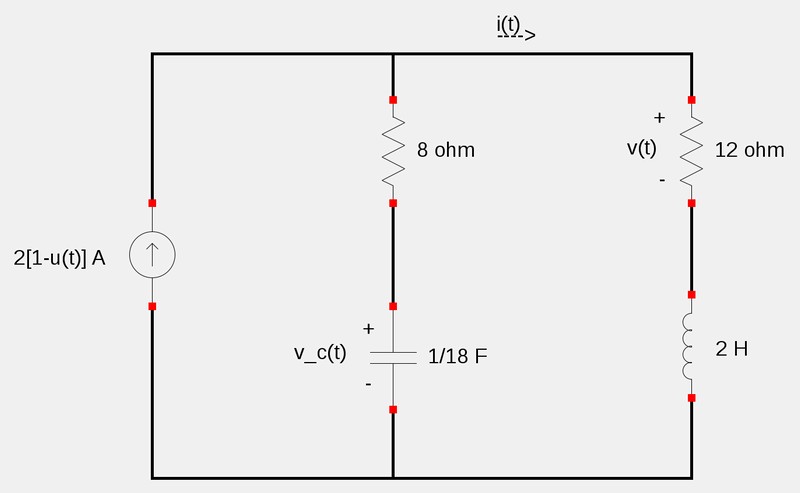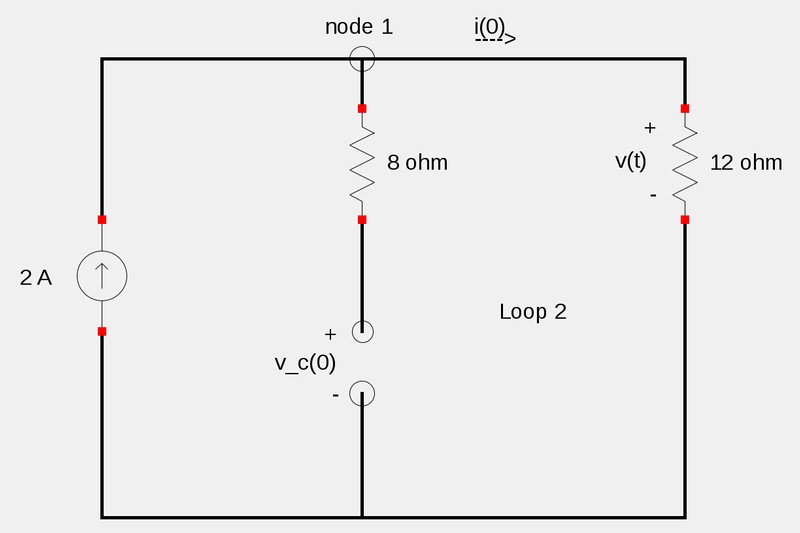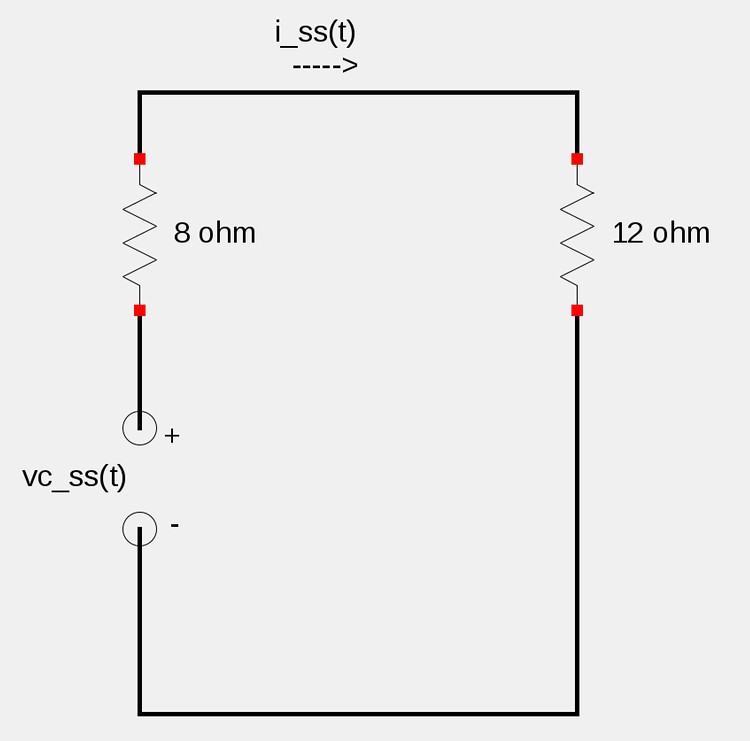For the following circuit, determine i(t) and v(t) for all t>0:

Note:
Although it may seem obvious when pointed out, make sure to realize that v(t) in this circuit is not the voltage across the capacitor. Although we are asked to find an expression for v(t), we will concern ourselves primarily with the voltage across the capacitor until the end when we will use Ohm's Law to solve for v(t).
Use definition of Heaviside Function to understand nature of current source:
Our current source is given as: $$2[1-u(t)] $$ or $$2-2u(t) \qquad(Expression \; 1)$$ Recall the definition of the Heaviside (Unit step) Function: $$ u_c(t) = \left\{ \begin{array}{ll} 0 & t \lt c \\ 1 & t \ge c \end{array} \right. $$ In our case c=0 (When c=0, the subscript is usually left blank.)
Using the definition of the Heaviside Function, we plug it into expression #1: $$ 2-2u_0(t) = 2 - 2\left\{ \begin{array}{ll} 0 & t \lt 0 \\ 1 & t \ge 0 \end{array} \right. $$ $$ = \left\{ \begin{array}{ll} 2 & t \lt 0 \\ 0 & t \ge 0 \end{array} \right. $$
1) Determine initial conditions and final values:
Consider the circuit for times sufficiently before t=0 so as to assume steady state conditions. Under steady state conditions, the inductor acts as a short circuit and the capacitor an open circuit. Furthermore, the current through an inductor and the voltage across a capacitor can't change instantaneously such that:
$$i(0^-) = i(0) = i(0^+) $$ $$v_C(0^-) = v_C(0) = v_C(0^+) $$ ...where "-" and "+" represent times just before and after t=0. The circuit under such conditions is represented below (Recall that we determined the value of the current source to be 2A for times t<0):

We can quickly determine that:
$$i(0) = 2 A $$
Using Kirchoff's Voltage Law (KVL) around loop 2, we get: $$-v_C(0) + 12i(0) = 0 $$ $$v_C(0) = 12(2) $$ $$v_C(0) = 24 V $$
In order to get a numerical value for i'(0), we consider the circuit for times just after t=0:

Recall the definition of voltage across an inductor: $$v_L(t) = L\frac{di}{dt} $$
Using KVL and the law of resistors in series, we get the following expression: $$-v_C(0) + 20i(0) + Li'(0) = 0 $$ $$-24 + 20(2) + 2i'(0) = 0 $$ $$2i'(0) = -16 $$ $$i'(0) = -8 $$
In order to get final values for "i" and the voltage across the capacitor, consider the circuit at times sufficiently above t=0 so as to assume steady state conditions. Once again, under steady-state conditions, we know that the inductor acts as a short circuit and the capacitor an open circuit:

We observe that: $$v(\infty) = 0 = v_{ss}(t) $$ $$i(\infty) = 0 = i_{ss}(t) $$ ...and we now have our:
Initial Conditions and Steady State values
$$i(0) = 2 $$ $$i'(0) = -8 $$ $$v_C(0) = 24 $$ $$v(\infty) = 0 $$ $$i(\infty) = 0 $$
2) Turn off independent sources and determine transient response for t>0:
At t>0, the independent current source is already off (As per our examination of the Heaviside function above). Once again we examine the circuit at times just after t=0:

Recall the definition of voltage across a capacitor: $$v_C(t) = v(0) + \frac{1}{C}\int_{}^{} i \; dt $$
Again we use KVL around the loop (clockwise), note that v_C(0) = -24 in terms of mesh current: $$-v_C(0) + \frac{1}{C}\int_{}^{} i \; dt + 20i + Li' = 0 $$ $$-24 + 18\int_{}^{} i \; dt + 20i + 2i' = 0 $$ $$2i' + 20i + 18\int_{}^{} i \; dt = 24 $$ Taking the derivative of the above expression: $$2i'' + 20i' + 18i = 0 $$ Dividing through by 2: $$i'' + 10i' + 9i = 0 \qquad(Expression \; 2)$$
letting: $$i = e^{st} $$ $$i' = se^{st} $$ $$i'' = s^2e^{st} $$ ...and substituting into expression #2:
$$ s^2e^{st} + 10se^{st} + 9e^{st} = 0 $$ $$ s^2 + 10s + 9 = 0 \; \qquad(characteristic \; equation)$$
Factoring our characteristic equation: $$(s+9)(s+1) = 0 $$ gives us roots of: $$s_{1,2} = -9 , -1 \qquad(roots \; of \; characteristic \; equation) $$
Determine nature of transient response:
Recall that for a series RLC circuit: $$\alpha = \frac{R}{2L} $$ and: $$\omega_0 = \frac{1}{\sqrt{LC}} $$
For our circuit: $$\alpha = \frac{20}{2(2)} = 5 $$ $$\omega_0 = \frac{1}{\sqrt{\frac{2}{18}}} = 3 $$
Since: $$5 \gt 3 $$ means that: $$\alpha \gt \omega_0 $$ ...we know that our circuit is overdamped and our complete response will be of the form: $$i(t) = i_{ss}(t) + Ae^{s_1t} + Be^{s_2t} $$ Plugging our previously determined values into the above expression gives us: $$i(t) = 0 + Ae^{-9t} + Be^{-t} $$ $$i(t) = Ae^{-9t} + Be^{-t} \qquad(Expression \; 3)$$ Taking the derivative of expression #3 gives us: $$i'(t) = -9Ae^{-9t} - Be^{-t} \qquad(Expression \;4) $$
Use initial conditions to solve for constants in expression #3:
Setting "t" equal to zero in expression #3 and using the initial condition for "i" gives us: $$i(0) = A + B = 2 \qquad(Equation \; 1)$$ Setting "t" equal to zero in expression #4 and using the initial condition for i'(t) gives us: $$ i'(0) = -9A - B = -8 \qquad(Equation \; 2)$$
Solving the system of two equations for eqn #1 and #2 gives us: $$A = \frac{3}{4} $$ $$B = \frac{5}{4} $$
Plugging A and B into expression #3 gives us our:
Value for i(t) for t>0:
$$i(t) = \frac{3}{4}e^{-9t} + \frac{5}{4}e^{-t}$$
In order to solve for v(t) (the voltage across the 12 ohm resistor), we once again consider the circuit for times t>0:

...and using Ohm's Law we have: $$v(t) = 12i(t) $$ $$v(t) = 12 \Big[\frac{3}{4}e^{-9t} + \frac{5}{4}e^{-t} \Big] $$ ...and we now have our:
Value for v(t) for t>0:
$$v(t) = 9e^{-9t} + 15e^{-t}$$
